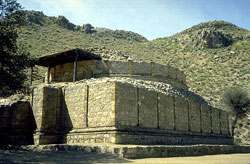The oldest part of Taxila is Bhir, which consists of several building phases:
-
the oldest stratum, usually dated to the sixth and fifth centuries BCE;
-
the fourth century, in which raja Ambhi entertained Alexander the Great in 326;
-
the stratum of the Mauryan empire, third century (the picture shows a part of the recently excavated water system)
-
and the uppermost stratum, which is everything after the Mauryan period.

The division between the first and second strata is a bit artificial. Even worse, the common identification of the oldest part of the city with the presence of the Achaemenid king Darius the Great in India in ca. 518 BCE is not based on archaeological finds. In his own texts, Darius claims to have conquered the Indus country, but until now, there is no archaeological confirmation. It would help if we found a Persian coin or cuneiform tablet.
Relief from the eastern stairs of the Apadana of the Persian capital Persepolis. The ancient told lots of tall stories about the proverbial wealth of the Punjab and the valley of the Indus. The Greek researcher Herodotus of Halicarnassus tells one of the most remarkable ones (text), which -no doubt- he had heard from a Persian spokesman.
There is some continuity from the oldest to the youngest levels. The main street (to the left on this picture) has been found on the same place in every stratum. The rest of the town changed considerably in the course of the centuries. It consisted of irregular, zig-zag, small streets and housing blocks made of bricks, stones and timber. There was a temple ('the pillared hall') and it is said that in the palace, the Mahabharata was recited for the very first time.
In 316, king Chandragupta of Magadha (321-297) conquered the Punjab. Taxila lost its independence and became a provincial capital. Yet, the city remained important as center of administration, education and trade. During the reign of Chandragupta's grandson Ashoka, Buddhism became important and the first monks settled in Taxila. They built the stupa called Dharmarajika, 'the tomb of the real law lord', i.e., the Buddha, because Ashoka had sent relics to several places in his empire. At the same time, Taxila was rebuilt. Unlike the pictures above, this one does not show the Mauryan stratum; instead you can see the older strata.
In c.184, the Greeks, who had maintained a kingdom in Bactria, invaded Gandara and the Punjab again. From now on, there was a Greek king living in Taxila, Demetrius. He seems to have ordered the rebuilding of the town on the plains north of Bhir mound. This second second city is called the Sirkap.
The greatest monument of Bhir mound, however, can not be shown: the scholars of Taxila. Panini, the author of a famous book on Sanskrit grammar, lived in Taxila; Caraka, a famous master of medicine had a house on Bhir mound too; and Kautilya, the Brahman adviser of Chandragupta Maurya and author of a guide to statecraft, the Arthasastra, was a resident of Taxila as well.



